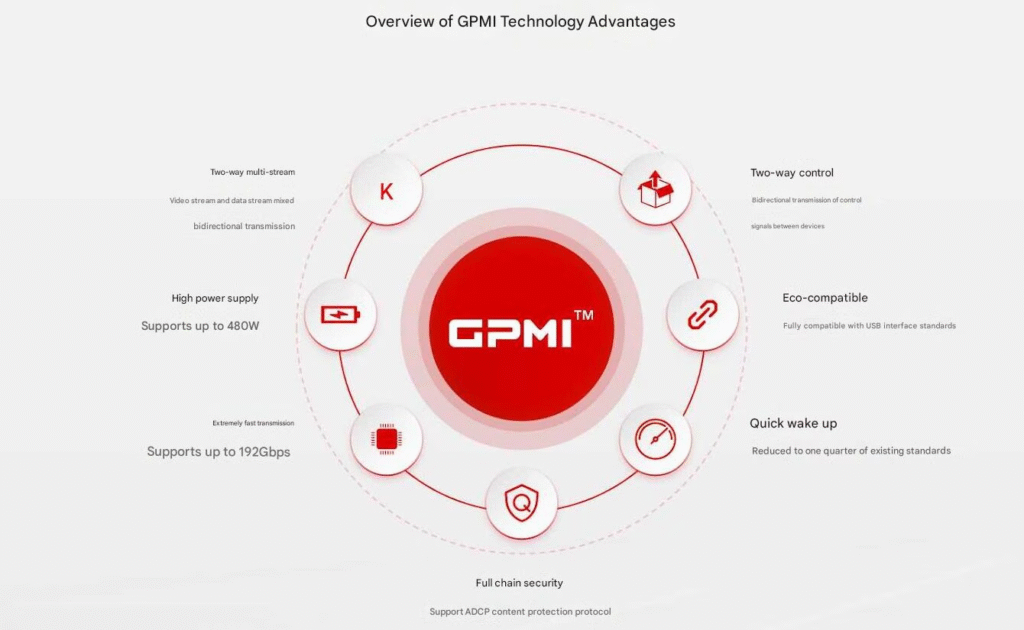Chinese companies have banded together to forge GPMI as an alternative to HDMI and DisplayPort.

In an era where seamless connectivity is paramount, China has introduced the General Purpose Multimedia Interface (GPMI), a revolutionary standard aiming to consolidate video, audio, data, and power transmission into a single cable. Developed by the Shenzhen 8K Ultra High Definition Video Industry Collaboration Alliance—which includes over 50 prominent Chinese tech companies such as Huawei, Skyworth, Hisense, and TCL—GPMI aspires to challenge the dominance of established standards like HDMI, DisplayPort, and Thunderbolt.
GPMI is planned to be available in two variants:

- GPMI Type-B: Featuring a proprietary connector, it doubles the bandwidth and power delivery of Type-C, reaching 192 Gbps and 480W. This is a significant advancement over HDMI 2.1’s 48 Gbps bandwidth and lack of power delivery.
- GPMI Type-C: Compatible with USB Type-C connectors, it offers up to 96 Gbps data transmission and 240W power delivery. This surpasses the capabilities of USB4 and Thunderbolt 4, which max out at 40 Gbps and 100W.
These specifications position GPMI as a future-proof solution capable of handling ultra-high-definition content, such as 8K at 120Hz, and powering high-performance devices like gaming laptops through a single cable.
GPMI’s design philosophy centers on unifying multiple functionalities:
- Bidirectional Communication: Supports two-way transmission of audio, video, data, and control signals, enabling devices to interact seamlessly.
- Mesh Networking: Facilitates daisy-chaining of up to 128 devices, simplifying complex setups.
- Content Protection: Incorporates the ADCP protocol, based on China’s national security cryptographic algorithms, offering an alternative to HDCP.
- Fast Wake-Up: Utilizes a sideband interaction channel to reduce device wake-up times, enhancing user experience.

These features aim to streamline user setups, reduce cable clutter, and enhance the interoperability of devices across various ecosystems.
GPMI’s development aligns with China’s broader strategy to reduce reliance on Western technologies and establish proprietary standards. The initiative has garnered support from major Chinese tech firms and has been showcased at events like the China Information Technology Expo (CITE) in Shenzhen.
While GPMI’s technical merits are evident, its global adoption faces challenges. The entrenched presence of HDMI and DisplayPort, along with geopolitical considerations, may hinder widespread acceptance. However, the USB-C compatibility of GPMI Type-C could facilitate gradual integration into international markets and ease the growing pains for the new standard.
If adopted widely, GPMI could revolutionize consumer electronics by:
- Simplifying Connections: Reducing the need for multiple cables by combining power, data, and video transmission.
- Enhancing Performance: Supporting higher resolutions and refresh rates, catering to the demands of gaming, virtual reality, and professional media production.
- Improving Aesthetics and Usability: Streamlining device setups, leading to cleaner workspaces and more user-friendly configurations.
These advantages could make GPMI an attractive option for manufacturers and consumers seeking efficient and high-performance connectivity solutions.
GPMI represents a significant technological advancement with the potential to reshape the landscape of multimedia connectivity. Its success will depend on industry adoption, compatibility considerations, and geopolitical dynamics. As the global demand for higher bandwidth and integrated solutions grows, GPMI could emerge as a formidable contender in the quest for a universal cable standard.

For further reading on this subject:
- Tom’s Hardware: China launches HDMI and DisplayPort alternative — GPMI boasts up to 192 Gbps bandwidth, 480W power delivery
- VideoCardz: China’s General Purpose Media Interface “GPMI” set to deliver up to 192Gbps of bandwidth and 480W power through a single USB cable
- TechSpot: China unveils GPMI, an HDMI and DisplayPort rival with 192 Gbps bandwidth and 480W power delivery
- Notebookcheck: New 480W and 192Gbps GPMI format signals China’s broader move beyond USB-C and Western cable standards
Other news from Tech Time:
- GPMI – China’s Ambitious Bid to Redefine Multimedia Connectivity with 192Gbps bandwidth at 480w
- Star Flash – China to replace Bluetooth with a new domestic standard
- Digital Device Defense for Disaster Readiness
- FBI warning about new Phantom Hacker scams targeting Coastal Bend senior citizens
- Introducing the Jetson ONE
For other technical services visit the rest of our site!





